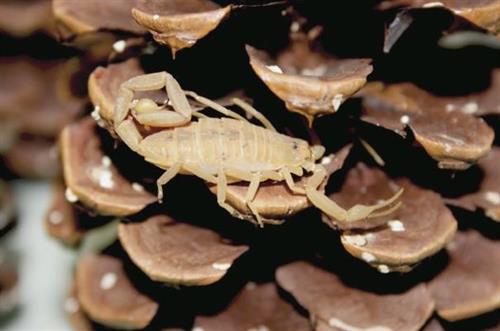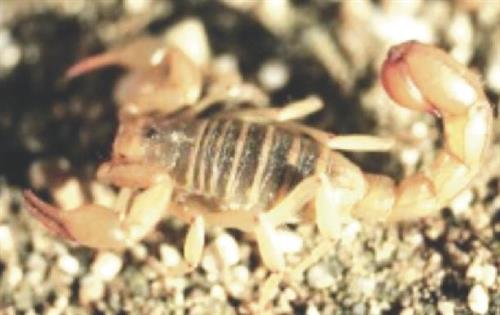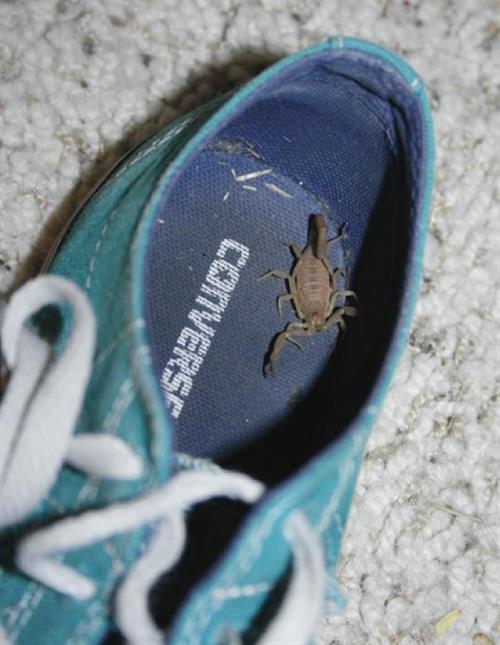 School & Home Integrated Pest Management (IPM) Newsletter – June 2018
School & Home Integrated Pest Management (IPM) Newsletter – June 2018
View this newsletter as a PDF.
Editor: Shujuan (Lucy) Li, lisj@cals.arizona.edu
Authored by Dawn H. Gouge, Shujuan (Lucy) Li, Christopher Bibbs,
and Shaku Nair, University of Arizona.
There are close to 2,000 described species of scorpions worldwide, at least 100 in the U.S., and more than 50 species in the desert southwestern states. Scorpions have long been of concern and interest to humans primarily due to their ability to give painful, and sometimes life threatening stings, but also because they are important and beneficial components of many ecosystems.
The most commonly occurring scorpion species in the low desert southwest include:
 Arizona bark scorpion Centruroides sculpturatus (Fig. 1). This species also colonizes small parts of California, Nevada, New Mexico, Utah, Colorado, Texas, and northwestern Mexico. Adults are 2-3 inches in length, have relatively slender appendages and a long, slender tail. Their coloration and markings are highly variable, some being pale in color, others darker with stripes or checkered patterning. The Arizona bark scorpion is the only scorpion of medical concern in the U.S. (Curry et al. 1983), and while all native scorpions can sting, only Arizona bark scorpion stings are hazardous to human health.
Arizona bark scorpion Centruroides sculpturatus (Fig. 1). This species also colonizes small parts of California, Nevada, New Mexico, Utah, Colorado, Texas, and northwestern Mexico. Adults are 2-3 inches in length, have relatively slender appendages and a long, slender tail. Their coloration and markings are highly variable, some being pale in color, others darker with stripes or checkered patterning. The Arizona bark scorpion is the only scorpion of medical concern in the U.S. (Curry et al. 1983), and while all native scorpions can sting, only Arizona bark scorpion stings are hazardous to human health.
 Arizona giant hairy scorpion Hadrurus arizonensis (Fig. 2) is the largest scorpion in the U.S.; they are heavy bodied scorpions, and adults often exceed 5 inches in length. This species can be found in the Sonoran and Mojave Desert areas of Arizona, California, Nevada andUtah, as well as the Sonoran and Baja California Norte areas of Mexico. They have a mild venom, but strong pedipalps that they use to grasp prey. The scorpions often have a darker body, pale sides, and pale buff colored appendages, when viewed from above. They feed on a wide variety of insects, arachnids, small lizards and other animals. This species is also called the desert hairy scorpion as they are found in low sandy areas.
Arizona giant hairy scorpion Hadrurus arizonensis (Fig. 2) is the largest scorpion in the U.S.; they are heavy bodied scorpions, and adults often exceed 5 inches in length. This species can be found in the Sonoran and Mojave Desert areas of Arizona, California, Nevada andUtah, as well as the Sonoran and Baja California Norte areas of Mexico. They have a mild venom, but strong pedipalps that they use to grasp prey. The scorpions often have a darker body, pale sides, and pale buff colored appendages, when viewed from above. They feed on a wide variety of insects, arachnids, small lizards and other animals. This species is also called the desert hairy scorpion as they are found in low sandy areas.
These harmless giants spend most of their time under rocks and in shallow burrows; they are a beneficial addition to your home landscape as they consume Arizona bark scorpions voraciously.
The Arizona stripe-tailed scorpion Paravaejovis spinigerus, and the yellow ground scorpion Vaejovis confusus (Fig. 3), are burrowing species, and full-grown at less than 3 inches in length. They are often mistaken for bark scorpions, but the stripe-tailed

Figure 3. Arizona stripe-tailed scorpion (left), and yellow ground scorpion (right)
(both about 1 inch in length). Black arrows show the pedipalps.
scorpion is heavily armored, with comparatively bulkier pedipalps (Fig. 3, left) and tail. Although yellow ground scorpions have more delicate pedipalps (Fig. 3, right), their tails are wider and much bulkier. Both scorpions feed on smaller arthropods, and seek moisture.
The Arizona stripe-tailed scorpion is found in Arizona, California, southwestern New Mexico and northwestern Sonora in Mexico, while the less commonly found, but broadly present yellow ground scorpion is reported throughout much of Arizona, California, Idaho, Nevada, Utah and northern Mexico.
Both scorpions are typically found on sandy soils in a variety of habitats, from desert floor to rocky hillsides, and under many surface objects (including sleeping bags, shoes, etc.) where they dig short burrows or “scrapes” for protection. The scorpions sting, but their venom is relatively mild, and does not usually require medical intervention.
 In the desert southwest, we share our space with the medically important Arizona bark scorpion, and our homes provide these amazing and adaptable scorpions with plentiful food, water, and shelter. To eliminate scorpions from our landscapes would require extremely unhealthy and illegal chemical use that would at best, be a temporary eradication of the pest. A far healthier and sustainable approach is to accept that scorpions are part of the natural landscape, and take precautions to exclude the creatures from the interior of homes and buildings. The following are useful tips for the safe and harmonious sharing of our incredible desert landscape.
In the desert southwest, we share our space with the medically important Arizona bark scorpion, and our homes provide these amazing and adaptable scorpions with plentiful food, water, and shelter. To eliminate scorpions from our landscapes would require extremely unhealthy and illegal chemical use that would at best, be a temporary eradication of the pest. A far healthier and sustainable approach is to accept that scorpions are part of the natural landscape, and take precautions to exclude the creatures from the interior of homes and buildings. The following are useful tips for the safe and harmonious sharing of our incredible desert landscape.
(Fig. 5).
Scorpions are extremely difficult to eradicate. If you regularly find scorpions inside your home, call a pest management professional experienced in the management of scorpions. Eliminating their food sources (crickets and other insects) can help, but will not eliminate scorpions from around the home. If a reduced scorpion population is desirable, additional steps can be taken. However, scorpions are difficult to manage with pesticides alone. Pest-proofing your home or structure is by far the most effective way to reduce scorpion contact and potential scorpion stings.
If you would like to know more, please read “Scorpions of the Desert Southwest United States” https://extension.arizona.edu/sites/extension.arizona.edu/files/pubs/az17682018.pdf